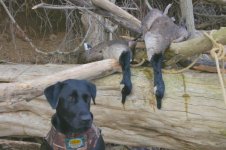MLBob Furia
Well-known member
Got to looking at the two geese I killed on the last day of the Indiana river-zone season Wednesday. My sons and I had taken quite a few Maximas in Ohio over the weekend which is what we commonly see in the SW Ohio/tristate area, but Wednesdays birds were definitely not Maximas. Smaller bodies (7-8 lb. range I'd guess - didn't weigh them) - but with a normal sized bill (not stubby like a Richardsons or Cackler). Definitely smaller feet than the big-uns.
Although it may not mean anything, they also had far less fat on them when I breasted them out - so maybe not residents or short-hoppers. All the Maximas we had taken earlier had thick layers of yellow fat when cleaned and had been taken in corn fields. These two came in separate from the big flocks I saw all afternoon and came as a pair.
Picture attached ... whaddya think?? Atlantic?... Interior?

Although it may not mean anything, they also had far less fat on them when I breasted them out - so maybe not residents or short-hoppers. All the Maximas we had taken earlier had thick layers of yellow fat when cleaned and had been taken in corn fields. These two came in separate from the big flocks I saw all afternoon and came as a pair.
Picture attached ... whaddya think?? Atlantic?... Interior?


